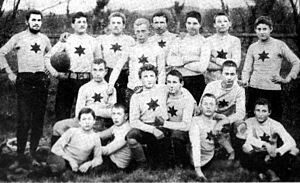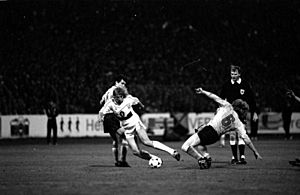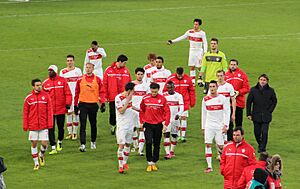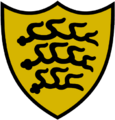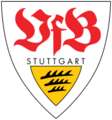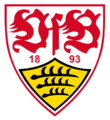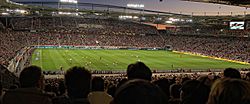VfB Stuttgart facts for kids
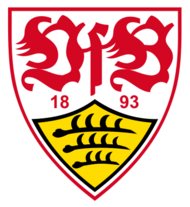 |
||||
| Full name | Verein für Bewegungsspiele Stuttgart 1893 e. V. | |||
|---|---|---|---|---|
| Nickname(s) | Die Roten (The Reds) Die Schwaben (The Swabians) |
|||
| Short name | VfB | |||
| Founded | 9 September 1893 | |||
| Ground | MHPArena | |||
| Capacity | 60,058 | |||
| President | Dietmar Allgaier | |||
| Chairman | Alexander Wehrle | |||
| Head coach | Sebastian Hoeneß | |||
| League | Bundesliga | |||
| 2020–21 | Bundesliga, 9th of 18 | |||
|
||||
VfB Stuttgart is a German professional sports club from Stuttgart, Baden-Württemberg. Their main team plays football in Germany's top league, the Bundesliga. VfB Stuttgart has won the national championship five times. They also won the DFB-Pokal four times and the UEFA Intertoto Cup twice. The club is known for being one of the best teams in Bundesliga history, ranking fourth in the all-time Bundesliga table.
The football team plays its home games at the MHPArena. This stadium is in the Neckarpark, close to the Cannstatter Wasen. The club also has a second team, VfB Stuttgart II, which plays in the 3. Liga. VfB Stuttgart's youth teams are very successful. They have won the national under 19 championships a record ten times. They also won the national under 17 championships seven times.
VfB Stuttgart is a large sports club with over 100,000 members. It is the biggest sports club in Baden-Württemberg. It is also the eighth-largest football club in Germany. The club has other sports sections too. These include fistball, field hockey, track and field, table tennis, and football referees. All these teams play at an amateur level. The club also has an esports team and a social group called VfB-Garde.
Contents
- Club History: From the Start to Today
- Team Colors and Uniforms
- Club Badges (Crests)
- Home Stadium: MHPArena
- Rivalries and Friendships
- Club Achievements and Trophies
- Club Management and Staff
- Players: Current and Past Stars
- Bundesliga Performance Over the Years
- See also
Club History: From the Start to Today
How VfB Stuttgart Began
VfB Stuttgart was created on April 2, 1912. This happened when two older clubs, Stuttgarter FV and FC Krone Cannstatt, joined together. They met at the Concordia hotel in Cannstatt. Both clubs were started by school students. These students learned new sports like rugby union and football from English people living in Germany. One important person was William Cail, who brought rugby to the area in 1865.
Stuttgarter FV's Early Days
Stuttgarter Fußballverein was founded on September 9, 1893. It started as a rugby club. They played games at Stöckach-Eisbahn before moving to Cannstatter Wasen in 1894. In 1908, the rugby club added a football section. The football team quickly became successful. In 1909, they were runners-up in the national rugby final. They lost 6–3 to FSV 1897 Hannover. People found rugby too hard to understand, so football soon became more popular.
In 1909, FV joined the South German Football Association. They played in the second division, called B-Klasse. In their second season, FV won a local final. They beat Kronen-Klub Cannstatt, which later joined with them. They eventually moved up to the top league, the Südkreis-Liga, in 1912.
Kronenclub Cannstatt's Story
Cannstatter Fußballklub started as a rugby club in 1890. They also quickly formed a football team. This club closed after a few years. Its former members then formed FC Krone Cannstatt in 1897. This new club focused only on football. They joined the South German Football Association as a second division club. In 1904, they won promotion. Krone had its own football field, which is still used today.
After the two clubs merged in 1912, the new team played in the Kreisliga Württemberg. Then they moved to the Bezirksliga Württemberg-Baden. They often finished in the top three and won a title there in 1927. The club also played in the final rounds of the South German Football Association in the late 1920s and early 1930s.
The 1930s and 1940s: A Time of Change
In 1933, VfB moved to Neckar Stadium, their current home. German football was reorganized that same year. Sixteen top divisions, called Gauligen, were created. Stuttgart played in the Gauliga Württemberg. They won division titles in 1935, 1937, 1938, 1940, and 1943. The Gauliga system ended during the 1944–45 season because of World War II. VfB had a strong rivalry with Stuttgarter Kickers during this time.
VfB's Gauliga titles allowed them to play in the national playoffs. Their best result was in 1935. They reached the final but lost 4–6 to Schalke 04. Schalke 04 was the strongest team back then. After finishing third nationally in 1937, Stuttgart could not get past the early rounds in later appearances.
Success in the 1950s
VfB continued to play in the top division, the Oberliga Süd. They won titles in 1946, 1952, and 1954. They regularly played in the German championship rounds. They became national champions in 1950 and 1952. They finished as runners-up in 1953. They also won two DFB-Pokal (German Cup) titles in 1954 and 1958. The team that won four titles in eight years was led by Robert Schlienz. He had lost his left arm in a car accident. Even with these wins, no Stuttgart player was on the team that won the 1954 FIFA World Cup.
Joining the Bundesliga
In 1963, the German Football Association (DFB) created a single professional league. This was called the Bundesliga. Stuttgart's strong performance in the 1950s earned them a spot. They were one of the 16 original clubs in the Bundesliga. The club was an amateur organization and careful with money. Some players even kept their regular jobs. For the next decade, until the mid-1970s, the club usually finished in the middle of the league table.
In 1973, the team played in the UEFA Cup for the first time. They reached the semi-finals of the 1974 tournament. They were knocked out by Feyenoord, who went on to win the cup.
1975–2000: A New Era and More Titles
VfB Stuttgart faced problems in the mid-1970s. They had not kept up with new trends like club sponsorship. They tried to spend money to become more professional, but it did not work. At the end of the 1974–75 season, VfB was in danger of being relegated. Local politician Gerhard Mayer-Vorfelder became the new president. However, a draw in the final game meant VfB finished 16th and lost its Bundesliga spot. Their first season in the second league was tough. They finished 11th and even lost a home game with only 1,200 fans watching.
With new coach Jürgen Sundermann and young talents like Karlheinz Förster and Hansi Müller, the team improved. They scored one hundred goals in 1976–77. This helped them return to the top league after just two seasons.
The young team was known for playing attacking football and scoring many goals. But they lacked experience. At the end of 1977–78, VfB finished fourth. Their average attendance of over 53,000 fans set a league record that lasted until the 1990s. In 1978/79, they finished second in the Bundesliga. They reached another UEFA Cup semi-final in 1980. They often finished in the top four. They won their first Bundesliga title, the club's third national title, in the 1983/84 season. This was under coach Helmut Benthaus.
In 1986, VfB lost the DFB-Pokal final 2–5 to Bayern Munich. In the 1989 UEFA Cup Final, with Jürgen Klinsmann on their team, they lost to Napoli. Diego Maradona was playing for Napoli at that time.
In 1991–92, Stuttgart won its fourth title. It was one of the closest races in Bundesliga history. They finished ahead of Borussia Dortmund because of a better goal difference. In European play, they were knocked out of the UEFA Cup that season (1991–92). They lost their second-round match to Spanish team Osasuna. As national champions, the club played in the UEFA Champions League in 1992–93. They were eliminated in the first round by Leeds United. A special third match was needed in Barcelona because coach Christoph Daum had used too many non-German players in the second game.
VfB did not qualify for European competitions again until 1997. They did this by winning their third German Cup with coach Joachim Löw. They reached the 1998 European Cup Winners' Cup final. There, they lost to Chelsea. After key players like Giovane Élber and Fredi Bobic left, only captain Krassimir Balakov remained from their "magic triangle" of players. Löw's contract was not renewed, and he was replaced by Winfried Schäfer, who was also sacked after one season.
Stuttgart's performance then dropped. The club finished in the middle of the table for the next two seasons. This happened even though they spent money on new players and had veterans like Balakov.
2000–2007: Back to Success
Due to high debts and poor results, Gerhard Mayer-Vorfelder left VfB in 2000. He took on roles at the DFB, UEFA, and FIFA. The new president, Manfred Haas, had to fix expensive player contracts. Like in 1976, the team had to be rebuilt using young talents from their youth teams. VfB has Germany's most successful youth program.
Coach Ralf Rangnick started to rebuild the team. They won the Intertoto Cup. But the extra games from the UEFA Cup made the team tired. They barely avoided relegation in 2001, finishing 15th. Rangnick was replaced by Felix Magath.
With players like Andreas Hinkel, Kevin Kurányi, Timo Hildebrand, and Alexander Hleb, the team was nicknamed "the young and wild." The club quickly improved. They finished as Bundesliga runners-up in the 2002–03 season. In July 2003, Erwin Staudt became the new president.
Champions League in 2003–04
VfB played in the Champions League for the second time in 2003–04. They beat Manchester United once and Rangers once. They also beat Panathinaikos twice. This helped them get through the group stage as runners-up to Manchester United. In the round of 16, they played against Chelsea. They lost 0–1 in the first game and drew 0–0 in the second, so they were eliminated.
Stuttgart continued to be one of the top teams in Germany. They finished fourth and fifth in the Bundesliga in 2003–04 and 2004–05. They also played in the UEFA Cup, but without much success. Coach Magath and several players left for other clubs. Kevin Kurányi went to Schalke 04, Philipp Lahm to Bayern Munich, and Alexander Hleb to Arsenal.
In the middle of the 2005–06 season, Giovanni Trapattoni was replaced by Armin Veh. Veh was seen as a temporary coach. He had left Hansa Rostock in 2003 to focus on his family. He had not coached since 2004, except for one season with his home team FC Augsburg. With help from new manager Horst Heldt, Veh focused on finding promising, affordable players instead of famous stars. Team captain Zvonimir Soldo retired, and other experienced players left. The team dropped to ninth place and did not qualify for European competition for the first time in four years.
Bundesliga Champions in 2006–07
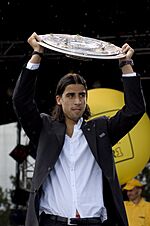
Despite losing games early in the 2006–07 season, coach Veh turned things around. He brought in new players like Mexicans Pável Pardo and Ricardo Osorio, Brazilian Antônio da Silva, and young local talents. These included Mario Gómez, Serdar Tasci, and Sami Khedira. On November 12, 2006, Stuttgart led the league for the first time in two years. They stayed in the top five and made a strong push for the Bundesliga title. They won their last eight games. On May 12, 2007, Stuttgart beat VfL Bochum 3–2 away from home. This put them ahead of Schalke 04 and guaranteed them a spot in the 2007–08 Champions League. In the final match against Energie Cottbus, Stuttgart came back from 0–1 down to win 2–1. They claimed their first Bundesliga title in 15 years. The celebrations in Stuttgart were huge, with 250,000 people. This was even bigger than the celebrations for Germany's third-place win in the 2006 FIFA World Cup.
VfB also had a chance to win the double (league and cup). They reached the German Cup final for the first time in ten years. Their opponents were 1. FC Nürnberg. Nürnberg had beaten them twice in the regular season. In the final, Stuttgart's scorer Cacau was sent off when the score was 1–1. Nürnberg took a 2–1 lead. But the ten men of VfB fought back and equalized. In extra time, Nürnberg scored the winning goal.
2007 to 2018: Ups and Downs
Champions League in 2007–08
In the 2007–08 UEFA Champions League draw, Stuttgart was grouped with Barcelona, Lyon, and Rangers. Their European journey started with a 2–1 defeat to Rangers. They also lost to Barcelona (0–2) and Lyon (0–2). With five defeats and only one win (against Rangers), they left the competition early. In the league, they finished sixth after a poor start. Star player Mario Gómez scored 19 goals.
They later qualified for the UEFA Cup by winning the 2008 UEFA Intertoto Cup.
After the Championship: 2008–12
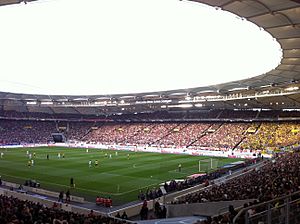
The 2008–09 season also started badly. In November, VfB was 11th in the table. Coach Armin Veh was sacked and replaced by Markus Babbel. After losing 1–5 to Bayern Munich in the German Cup, things improved. The team finished third in the league, just missing second place after a loss to Bayern on the last day. This gave them a chance to play in the Champions League again.
In Europe, VfB got through the group stages of the 2008–09 UEFA Cup. But they lost to the defending champions Zenit Saint Petersburg in the round of 32.
For the 2009–10 season, Mario Gómez left for Bayern Munich. Pavel Pogrebnyak arrived from Zenit Saint Petersburg, and Alexander Hleb returned on loan.
Stuttgart had a big success by qualifying for the 2009–10 UEFA Champions League group stage. They beat Romanian team Politehnica Timișoara. This was their third time in the Champions League in six years. They were drawn into a group with Sevilla, Rangers, and Unirea Urziceni. With two wins, three draws, and one loss, they finished second in the group. This meant they reached the round of 16, where they faced Barcelona. After a 1–1 home draw, Stuttgart was eliminated after a 0–4 loss at Camp Nou.
In the 2009–10 DFB-Pokal, they lost in the round of 16 to second-tier team SpVgg Greuther Fürth. This defeat came during a difficult first half of the 2009–10 Bundesliga. Because they dropped to 16th place in December, young coach Markus Babbel was fired. He was replaced by the more experienced Swiss coach Christian Gross. Under Gross, VfB improved before the winter break. During the break, some players left, and Cristian Molinaro joined on loan. In the second half of the season, the team played very well. They climbed up the table and qualified for the Europa League.
The 2010–11 season was average. They spent the first half of the season near the relegation zone. Christian Gross was fired, and Jens Keller took over temporarily. Bruno Labbadia was hired as the new coach in January. He managed to save VfB from relegation. The team finished 12th after a good second-half performance. In July 2011, Gerd E. Mäuser was elected president.
In the 2011–12 season, they steadily moved up the table. This was thanks to a long unbeaten run in the spring. VfB qualified for the 2012–13 UEFA Europa League. Key players were Martin Harnik, who scored 17 goals, and new players Gōtoku Sakai and Vedad Ibišević.
On June 3, 2013, Gerd E. Mäuser resigned as president. On July 2, 2013, Bernd Wahler was chosen as the candidate for the presidential elections. Wahler was elected on July 22, 2013, with 97.4% of the votes.
After barely avoiding relegation in the 2014–15 season, Stuttgart was relegated to the 2. Bundesliga in the 2015–16 season. They finished 17th and could not escape the bottom three. After a 4–0 home loss, Alexander Zorniger's contract was ended. Jürgen Kramny became the manager. After relegation, Wahler resigned as president on May 15, 2016. Kramny was also sacked.
On May 17, 2016, Jos Luhukay became the new head coach. In July 2016, Jan Schindelmeiser became the sporting director. Coach Luhukay resigned on September 15, 2016. Hannes Wolf replaced him. At the end of the season, Stuttgart returned to the Bundesliga as champions of the 2. Bundesliga. On December 22, 2017, Mario Gómez returned to the team. The team had a good return season, finishing 7th. However, they dropped to 16th in the next season. They were relegated after losing in the play-offs against Union Berlin.
2019–Present: A Strong Comeback
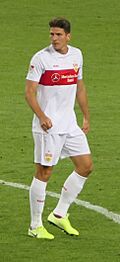
Stuttgart appointed Thomas Hitzlsperger as the sporting CEO. In April, they hired Sven Mislintat as the sporting director. In July 2019, Stuttgart was relegated to the second division again. They started to rebuild the team. In December 2019, coach Tim Walter was fired. Pellegrino Matarazzo was hired. After one season, Stuttgart returned to the Bundesliga. They finished second in the 2019–20 2. Bundesliga season.
Stuttgart stayed in the Bundesliga in the 2020–21 season, finishing ninth. In the 2021–22 season, the team barely avoided relegation. A last-minute win against 1. FC Köln on the final day kept them in the top league. In the 2022–23 season, Stuttgart again managed to stay in the Bundesliga. They finished 16th and won their play-off games.
The 2023–24 season was one of the club's most successful. Stuttgart was often called "the surprise team of the season." They had their best Bundesliga season ever based on wins. They stayed in 3rd place for most of the season, behind Leverkusen and Bayern. On the final day, they passed Bayern Munich to finish as Bundesliga runners-up. This was the club's best performance since winning the league in 2007. They also reached the quarter-finals in the DFB Pokal. They beat 1. FC Union Berlin and Borussia Dortmund before losing to Bayer Leverkusen. Strikers Serhou Guirassy and Deniz Undav were among the top goalscorers worldwide. Guirassy even broke Stuttgart's record for most goals in a season. Deniz Undav, Alexander Nübel, Chris Führich, Maximilian Mittelstädt, and Waldemar Anton were chosen for the Germany national team's preliminary squad for the UEFA Euro 2024. This was a club record for the number of players selected for a major tournament.
The club started the 2024–25 season with a tough 4–3 shootout loss to Leverkusen in the 2024 DFL-Supercup. They had qualified for this competition by finishing 2nd in the league. They did not repeat their success in the league, finishing 9th. They also had a club record of six straight home defeats in the Bundesliga. In the 2024–25 UEFA Champions League league phase, they finished 26th and missed the knockout playoffs after a 4–1 loss to PSG. However, they had a memorable 1–0 away win against Juventus FC. The club still qualified for Europe by winning the 2024–25 DFB-Pokal. They won 4–2 against Arminia Bielefeld in the final. This win means they will play in the 2025–26 UEFA Europa League and host the 2025 Franz Beckenbauer Supercup against Bayern Munich.
Team Colors and Uniforms
| For more details, see VfB Stuttgart kits |
- Current sports brand: Jako.
- Home uniform: White shirt with a red stripe, white shorts, and white socks.
- Away uniform: Red shirt, red shorts, and red socks.
- Third uniform: Dark green or yellow shirt, dark green or yellow shorts, and dark green or yellow socks.
|
First
|
(See evolution)
|
Currently
|
Kit Makers and Sponsors
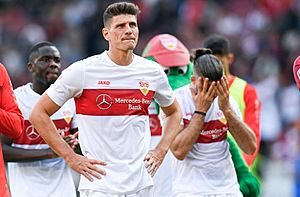
| Period | Kit manufacturers | Shirt sponsor | Sleeve sponsor |
|---|---|---|---|
| 1975–1976 | Adidas | None | None |
| 1976–1977 | Frottesana | ||
| 1977–1978 | Erima | ||
| 1978–1979 | Adidas | ||
| 1979–1980 | Erima | Canon | |
| 1980–1982 | Adidas | ||
| 1982–1986 | Dinkelacker | ||
| 1986–1987 | Sanwald Extra | ||
| 1987–1997 | Südmilch | ||
| 1997–1999 | Göttinger Gruppe | ||
| 1999–2002 | Debitel | ||
| 2002–2005 | Puma | ||
| 2005–2010 | EnBW | ||
| 2010–2012 | GAZİ | ||
| 2012–2017 | Mercedes-Benz Bank | ||
| 2017–2019 | GAZİ | ||
| 2019–2023 | Jako | Mercedes-EQ | |
| 2023– | Winamax | hep Global |
Club Badges (Crests)
Home Stadium: MHPArena
VfB Stuttgart plays its home games at the MHPArena. This stadium was first built in 1933. It is located near the River Neckar in Bad Cannstatt. It is also close to the new Mercedes-Benz Museum and factory. The stadium has been updated many times. It can now hold up to 60,058 fans. For international matches, the capacity is 50,000.
The stadium, originally called Gottlieb-Daimler-Stadion, was a venue for the 1974 FIFA World Cup. It also hosted five games in the 2006 FIFA World Cup. These included a match between England and Ecuador. It also hosted the third-place game between Germany and Portugal. From the 2008–09 season, the stadium was renamed the Mercedes-Benz-Arena. It was recently rebuilt to be a football-only stadium. In 2011, its capacity increased to 60,449.
Rivalries and Friendships
VfB Stuttgart has a long-standing rivalry with Stuttgarter Kickers. This is a city rivalry, known as Die Roten (The Reds) against Die Blauen (The Blues). However, the main teams have not played each other since 1992. Because of this, the rivalry with Karlsruher SC has become more important. This is called the Baden-Württemberg-Derby. It reflects old feelings between the Badenese and Württemberg regions. The rivalry with Bayern Munich is mostly one-sided. VfB fans dislike Bayern for often buying their best players and coaches. Examples include Giovane Élber, Felix Magath, Mario Gómez, and Benjamin Pavard.
VfB also has regional friendships. These are with SSV Reutlingen 05 (seen as VfB's "little brother") and SpVgg Ludwigsburg. They also have a friendship with FC Heidenheim. In the past, VfB supporters were close with fans of Energie Cottbus, 1. FC Saarbrücken, Bayer Leverkusen, and Eintracht Frankfurt. Most of these friendships have ended or are only kept by a few fan groups today. Current strong fan friendships are with the ultras of SSV Reutlingen 05 and Italian club Cesena.
In 2005, VfB signed an agreement with Swiss club St. Gallen. This cooperation focuses on developing young players in both clubs.
Club Achievements and Trophies
National Titles
- German Championship/Bundesliga
- Champions: 1950, 1952, 1983–84, 1991–92, 2006–07
- Runners-up: 1935, 1953, 1978–79, 2002–03, 2023–24
- 2. Bundesliga
- Winners: 1976–77, 2016–17
- Runners-up: 2019–20
- DFB-Pokal (German Cup)
- Winners: 1953–54, 1957–58, 1996–97, 2024–25
- Runners-up: 1985–86, 2006–07, 2012–13
- DFB/DFL-Supercup
- Winners: 1992
- Runners-up: 2024
- DFL-Ligapokal
- Runners-up: 1997, 1998, 2005
International Titles
- UEFA Cup
- Runners-up: 1988–89
- UEFA Cup Winners' Cup
- Runners-up: 1997–98
- UEFA Intertoto Cup
- Winners: 2000, 2002 (shared record)
Other Wins
- Fuji-Cup
- Winners: 1989
- Uhrencup
- Winners: 2010
Regional Titles
- Oberliga Süd
- Winners: 1945–46, 1951–52, 1953–54
- 2nd Bundesliga Süd
- Winners: 1977
- Bezirksliga Württemberg-Baden
- Winners: 1926–27, 1929–30
- Gauliga Württemberg
- Winners: 1934–35, 1936–37, 1937–38, 1942–43
Youth Team Success
- German Under 19 championship
- Champions: 1972–73, 1974–75, 1980–81, 1983–84, 1987–88, 1988–89, 1989–90, 1990–91, 2002–03, 2004–05 (record)
- Under 19 Juniors DFB-Pokal
- Winners: 1996–97, 2000–01, 2018–19, 2021–22
- German Under 17 championship
- Champions: 1985–86, 1993–94, 1994–95, 1998–99, 2003–04, 2008–09, 2012–13
Club Management and Staff
Current Coaching Staff
Players: Current and Past Stars
Current Squad
|
|
Players on Loan
|
|
Famous Former Players
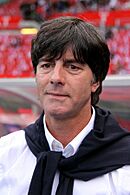
In 2012, for the 100th anniversary of the club's merger, fans voted for the "Centenary Eleven." This was a special team of the best players from the club's history.
|
|
Player Records
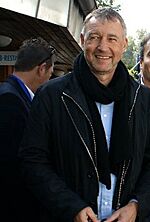
|
|
Bundesliga Performance Over the Years
VfB Stuttgart has had many ups and downs in the Bundesliga since it started in 1963. They have often been a strong team, finishing in the top half of the table. They won the league title in 1984, 1992, and 2007. They also finished as runners-up several times, including recently in 2024. The club has been relegated to the second division a few times, but they always managed to get back to the top league quickly.
See also
 In Spanish: VfB Stuttgart para niños
In Spanish: VfB Stuttgart para niños


